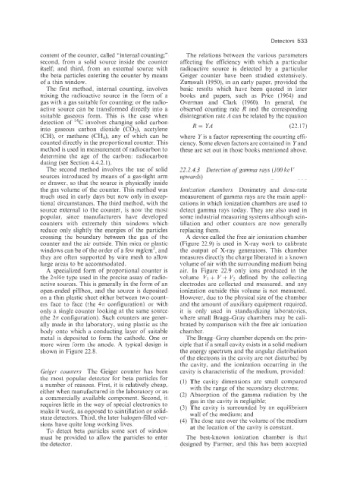Page 551 - Instrumentation Reference Book 3E
P. 551
Detectors 533
content of the counter, called “internal counting;” The relations between the various parameters
second, from a solid source inside the counter affecting the efficiency with which a particular
itself; and third, from an external source with radioactive source is detected by a particular
the beta particles entering the counter by means Geiger counter have been studied extensively.
of a thin window. Zumwalt (19501, in an early paper, provided the
The first method, internal counting, involves basic results which have been quoted in later
mixing the radioactive source in the form of a books and papers, such as Price (1964) and
gas with a gas suitable for counting; or the radio- Overman and Clark (1960). In general, the
active source can be transformed directly into a observed counting rate R and the corresponding
suitable gaseous form. This is the case when disiiitegration rate A can be related by the equation
detection of I4C involves changing solid carbon R= YA (21.17)
into gaseous carbon dioxide (CO?), acetylene
(CH), or methane (CH& any of which can be where Y is a factor representing the counting effi-
counted directly in the proportional counter. This ciency. Some eleven factors are contained in Yand
method is used in measurement of radiocarbon to these are set out in those books mentioned above.
determine the age of the carbon: radiocarbon
dating (see Section 4.4.2.1).
The second method involves the use of solid 22.2.4.3 Detection of gainnia rays (100 keV
sources introduced by means of a gas-tight arm upwards)
or drawer. so that the source is physically inside
the gas volume of the counter. This method was Ionization chanibera Dosimetry and dose-rate
much used in early days but now only in excep- measurement of gamma rays are the main appli-
tional circumstances. The third method, with the cations in which ionization chambers are used to
source external to the counter, is now the most detect gamma rays today. They are alsn used in
popdar, since manufacturers have developed some industrial measuring systems although scin-
counters with extremely thin windows which tillation and other counters are now generally
reduce only slightly the energies of the particles replacing them.
crossing the boundary between the gas of the A device called the free air ionization chamber
counter and the air outside. Thin mica or elastic (Figure 22.9) is used in X-ray work to calibrate
windows can be of the order of a few mglcm-, and the output of X-ray generators. This chamber
they are often supported by wire mesh to allow measures directly the charge liberated in a known
large areas to be accommodated. volume of air with the surrounding medium being
A specialized form of proportional counter is air. In Figure 22.9 only ions produced in the
the 2d4n type used in the precise assay of radio- volume VI + V + Vz defined by the collecting
active sources. This is generally in the form of an electrodes are collected and measured. and any
open-ended pillbox, and the source is deposited ionization outside this volume is not measured.
on a thin plastic sheet either between two count- However, due to the physical size of the chamber
ers face to face (the 47i configuration) or with and the amount of auxiliary equipment required,
only a single counter looking at the same source it is only used in standardizing laboratories,
(the 27i configuration). Such counters are gener- where small Bragg-Gray chambers may be cali-
ally made in the laboratory, using plastic as the brated by comparison with the free air ionization
body onto which a conducting layer of suitable chamber.
metal is deposited to form the cathode. One or The Bragg-Gray chamber depends on the prin-
inore wires form the anode. A typical design is ciple that if a small cavity exists in a solid medium
shown in Figure 22.8. the energy spectrum and the angular distribution
of the electrons in the cavity are not disturbed by
the cavity, and the ionization occurring in the
Geigu coiiiu’ers The Geiger counter has been cavity is characteristic of the medium, provided:
the rnost popular detector for beta particles for (1) The cavity dimensions are small compared
a number of reasons. First, it is relatively cheap, with the range of the secondary electrons;
either when manufactured in the laboratory or as (2) Absorption of the gamma radiation by the
a commercially available component. Second, it gas in the cavity is negligible;
requires little in the way of special electronics to (3) The cavity is surrounded by an equilibrium
make it work, as opposed to scintillation or solid- wall of the medium: and
state detectors. Third, the later halogen-filled ver- (4) The dose rate over the volume of the medium
sions have quite long working lives. at the location of the cavity is constant.
To detect beta particles some sort of window
must be provided to allow the particles to enter The best-known ionization chamber is that
the detector. designed by Farmer, and this has been accepted

